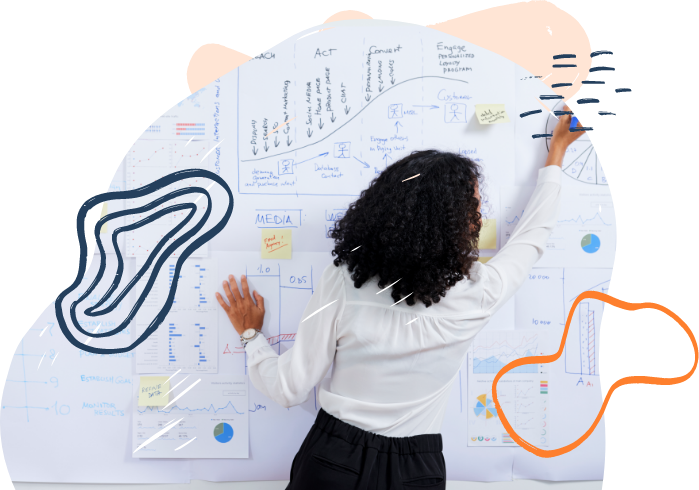What keeps a customer coming back and contributing to your revenue growth? Firstly, it's essential that your customers are satisfied with your product or service. Product satisfaction is crucial when it comes to retaining your high-value customers for extended periods of time.
But how do you figure out who is REALLY contributing to your business's higher revenue growth? Well, that's where one of the most important SaaS metrics comes into play — Customer Lifetime Value(CLV).
Read more to learn about CLV and why it can't be ignored.
Table of Contents
1. What is Customer Lifetime Value?
2. Why is Customer Lifetime Value Important? Why does it matter?
3. Types of Customer Lifetime Value
4. How to calculate Customer Lifetime Value
5. Customer Lifetime Value formula
6. Customer Lifetime Value example
7. 8 Ways to increase Customer Lifetime Value
8. Customer Lifetime Value statistics
9. Conclusion — Track, calculate and improve Customer Lifetime Value with Billsby
What is Customer Lifetime Value?
Customer Lifetime Value (CLV) measures how valuable your customers are to you, not just on an individual purchase-by-purchase basis but throughout their entire relationship with your company. It's a valuable statistic as it considers all previous purchases and interactions that lead them towards becoming loyal consumers.
This guide provides insights about calculating customer lifecycle values, the factors that affect them and other helpful information for entrepreneurs looking to grow their companies.
Why is Customer Lifetime Value Important? Why does it matter?
CLV is a great way to measure the success of your customer acquisition efforts. It will help you guide strategies like retention, critical marketing, sales, cross-selling and upselling for your subscription business so that these initiatives are more successful for both customers and distributors.
Below are a few key reasons emphasizing the importance of customer lifetime value:
1) Improves customer retention- One of the most critical factors in addressing customer lifetime value is improving retention rates and avoiding attrition.
Tracking these details can help you identify your best customers, so that they are not lost to other competitors, but also to help you determine what's working well for them and use those insights as guidance.
2) Helps in making better decisions on customer acquisition costs(CAC)- When you know how much money an existing customer can generate, it makes the decision on CAC clearer. The average SaaS company spends 5 to 7 times more on acquiring customers than they would spend on retaining existing ones. To ensure profitability for SaaS business, a guideline states - CLV > 3x CAC, i.e., the cost of acquiring a customer, should be considerably lower than what you can make from them in their lifetime. It may seem elementary, but if this maths is missed out on, your SaaS business could struggle financially over time.
3) Drive repeat sales– Customer lifetime value analysis is a great way to strategize how you can increase repeat business.
By tracking the average number of visits per year or over their lifetime, SaaS businesses and other companies will be able to see what strategies work best for them to retain current customers whilst also attracting new ones.
4) A better understanding of customer behaviour- By dividing customer data into different segments, you can identify which groups of customers are most likely to churn or become unhappy and then take steps accordingly.
In addition, by using lookalike modeling businesses may be able to acquire new clients who share similar needs as their current ones.
5) Improved forecasting- Forward-looking decisions around inventory, staffing and production capacity can be challenging without a customer lifetime value forecast.
Without the right data, it's easy to either spend more than you should, or underspend and then put yourself in a dangerous bind where the demand outstrips your ability for supply or vice versa.
With average customer lifetime value, all of this will become much easier as soon as you consider how many units are ready now vs expected later.
Types of Customer Lifetime Value
CLV can be further divided into the following types:
1) Historical Customer Lifetime Value
Historical CLV measures a customer's lifetime value based on how much money they've spent with a company in the past. Historical CLV can be calculated in two ways: using the average revenue per user (ARPU) or using cohort analysis.
Customer habits, fluctuations, and preferences are not considered while calculating CLV historically.
2) Predictive Customer Lifetime Value
The predictive CLV model is more complex than the historical model. Predictive CLV employs artificial intelligence and machine learning to estimate future customer lifetime and revenue based on past customer behaviour and predicted retention.
This model, by definition, considers customer trends and behaviours throughout a customer's lifetime.
How to Calculate Customer Lifetime Value
1) Identify your average order value-Begin by determining the average sale value. If you've only been tracking this data for a short time, consider using a one- or three-month period as a proxy for the entire year.
2) Measure the average number of transactions per period- The frequency of visits is fundamental to driving customer lifetime value.
For instance, coffee shops and car dealerships have different needs regarding frequency, as customers may come in several times weekly at the former but only once every few years or so if they visit your dealership instead.
3) Examine your customer retention- Brand loyalty can be a measure of how long your customers stay with you. Therefore, it is important to measure customer retention to know how long the average person sticks with your brand. Some brands, like technology and car companies, have lifelong loyalty. In contrast, others may only experience it for a shorter period of time due to their product or service being less expensive than other options available in the market, such as gas stations/retail chains.
4) Calculate Customer Lifetime Value– The CLV calculation uses all of the figures you’ve identified above in a handy formula that’s discussed in the next section of this guide. Customer Lifetime Value Formula
Now that we are aware of the CLV metric, let's see how to calculate it-
Here is the formula for lifetime value of a customer-
CLV = Average Transaction Size x Number of Transactions x Retention Period
There’s a plethora of ways you can grow your customer's lifetime value,but every move has consequences. For example- if the price goes up, it may improve average transaction size but could push customers to shop less often or look for lower-cost alternatives.
Customer Lifetime Value Example
For instance, let’s create a hypothetical organisation and calculate the lifetime value of a customer. The average sale for the clothing retailer, Alena, is $60, and the average customer shops with them three times per year for two years. The lifetime value of this customer is measured as follows:
Lifetime Value = $60 × 3 × 2 = $360After measuring the cost of goods sold (COGS), overhead, marketing, and all other administrative expenses, Alena’s profit margin is 20%.
Customer Lifetime Value = $60 × 3 × 2 × 20% = $360 × 20% = $72
This calculation reveals that the customer lifetime value of the average Alena customer is $72 — much less than the lifetime value calculated above. As a retailer, this number is the most critical metric to monitor because it helps them understand how many customers they need in order to reach their desired profits.
8 ways to increase Customer Lifetime Value
There are numerous strategies that businesses can use to increase their CLV. Here are 8 ideas to consider if you want to increase revenue from your customers:
1) Programs for customer loyalty or rewards- Customer loyalty programmers keep customers interested and encourage repeat purchases. Popular examples include airline frequent flyer programmers and restaurant punch cards. In addition, incentives for returning customers can increase purchase frequency and the length of time a customer spends with a brand.
2) Enhance Customer Onboarding- Some customers purchase a product or service from a company and are unsure what to do next. This frustration can cause them to leave early. Successful businesses chart a course for their customer relationships. In many industries, converting a one-time customer into a source of recurring revenue is critical for growth.
3) Customer Service and Experience- The customer experience includes your initial website, storefront, call centre, and other touchpoints. Customers are more likely to return for repeat business if they have a pleasant, low stress experience every time.
4) Customer engagement- Businesses that actively monitor all interactions with their customers can identify ways to improve the customer experience and customer loyalty. This should include channels such as advertising, customer service, and sales.
5) Customer feedback loop- It is important not to dismiss a negative consumer experience. Businesses should collect consumer feedback, good or bad, on a frequent basis to improve the customer experience, rather than relying on customer service to handle problems. Regular iterations and fixes to a product or service can assist in resolving faults and increasing client happiness.
6) Cross-sell and upsell- Retaining or upselling an existing customer is typically easier than acquiring a new one. Upselling and cross-selling are marketing methods that urge customers to purchase more expensive or more products or services at once rather than a cheaper one.
7) Increase pricing- A price increase can directly raise customer lifetime value when done appropriately. You need to be careful not to scare customers away with drastic price rises. When choosing your own price, keep rival pricing in mind. You might be able to increase pricing without losing clients if you focus on value and provide customers with something they can't get anywhere else.
8) Targeted Content- Content marketing is a method for educating or entertaining your target audience with the goal of increasing brand trust and loyalty.
Blog posts, e-books, videos, podcasts, and other focused content that can speak to certain portions of your audience are all popular content marketing strategies.
Customer Lifetime Value Statistics
1) A 5% improvement in customer retention results in a 25% increase in earnings.
2) It costs 5-25 times more to acquire a new customer than it does to keep an existing one.
3) Converting an existing customer has a 60-70% chance of being successful.
4) On average, existing consumers spend 67% more than new customers.
5) Customer Lifetime Value is viewed as an important metric by 76% of businesses.
Conclusion — Track, calculate and improve Customer Lifetime Value with Billsby
Our subscription billing software, Billsby, has sophisticated analytical capabilities that can provide various customer value statistics, removing the need to cobble together metrics with a spreadsheet manually. Billsby provides dashboards and tools to calculate CLV instantly, including the option to slice up the data by segment. In addition, Billsby offers CRM and e-commerce systems that can track all the data needed for multi-channel businesses to calculate CLV and understand how it changes over time. These systems are all part of a unified platform that presents a central source of information for the entire organisation without the need for third-party integrations.










